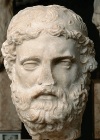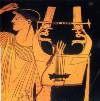An old favorite, discovered in my graduate school days, Anacreon (570–488 BCE) is one of the great poets of drinking parties, the many varieties of love, and the sweetness of life in the shadow of death.

Infatuation from a distance:
O sweet boy like a girl,
I see you though you will not look my way.
You are unaware that you handle the reins of my soul.
Explaining rejection by a girl at a party:
Not that girl — she’s the other kind,
one from Lesbos. Disdainfully,
nose turned up at my silver hair,
she makes eyes at the ladies.
More seriously, the theodicy problem:
Here lies Timokritos: soldier: valiant in battle.
Arês spares not the brave man, but the coward.
And even more seriously, the end of life and the approach of death:
I have gone gray at the temples,
yes, my head is white, there’s nothing
of the grace of youth that’s left me,
and my teeth are like an old man’s.
Life is lovely. But the lifetime
that remains for me is little.
For this cause I mourn. The terrors
of the Dark Pit never leave me.
For the house of Death is deep down
underneath; the downward journey
to be feared; for once I go there
I know well there’s no returning.

I came back to Anacreon recently because he features as a character in The Praise Singer, a fictionalized life of Simonides by the excellent Mary Renault. Simonides was another of the great lyric poets, long lived and widely traveled. Renault’s novel spans Greek history from Polykrates and Peisistratus, tyrants of Samos and Athens respectively, through the Athens of Hipparchus the art patron and Themistocles the naval genius, to Thessaly and Syracuse.
Simonides is most known to our generation as composer of the epitaph at Thermopylae, after the out-numbered Greeks held off a huge force of Persians for three days:
Four thousand of us fought three million.
When you visit Sparta, tell them:
Here, the soldiers kept their word.
If you love historical fiction and the Greeks, then Mary Renault is your author. Her fictionalized versions of the Hellenic world are all historically rich and realistic and with characters whom you come to care about.
My favorites are The King Must Die, The Mask of Apollo, and The Persian Boy. The first focuses on the legend of Theseus during his bull-leaping years as hostage to the Cretan empire. The Mask of Apollo is set in Athens and Sicily, weaving together the tumultuous theatrical and political worlds of the time. The Persian Boy tells the story of the mature Alexander and his conquests from the perspective of Bagoas, the beautiful Persian youth who was his lover.
I share your liking of Mary Renault, although my opinion is that she appeals to juveniles or dilettantish older folks. My favorite is the book on Simonides, it puts one beside the musician-poet. The ultimate female authority on antiquity is Edith Hamilton, in my view, the greatest American lady-scholar. THE GREEK WAY is a must for any liberal arts student. Then, THE ROMAN WAY (written incidentally, she confides in the intro). Her MYTHOLOGY, while not exhaustive, has more authority than larger tomes (such as Bullfinch) and abounds in pungent observations. For anyone who likes medieval fiction, there is a little known classic THE GOLDEN WARRIOR by Hope Muntz, a Canadian authoress. It is written in skaldic form and very well written too! But, try to find a copy!
A new lady writer (whose name escapes) has written several books about the Hellenistic period, one about Archimedes and another about Caesar and Cleopatra’s son, Caesarion. The author was a classical scholar and any librarian should be able to find the books for you. She also wrote a book about the Middle Ages about a person who could change into a wolf, which seems most credible, as her pen brings the character to life.
I ordered the Muntz book. Thanks for the recommendation, Stephen.